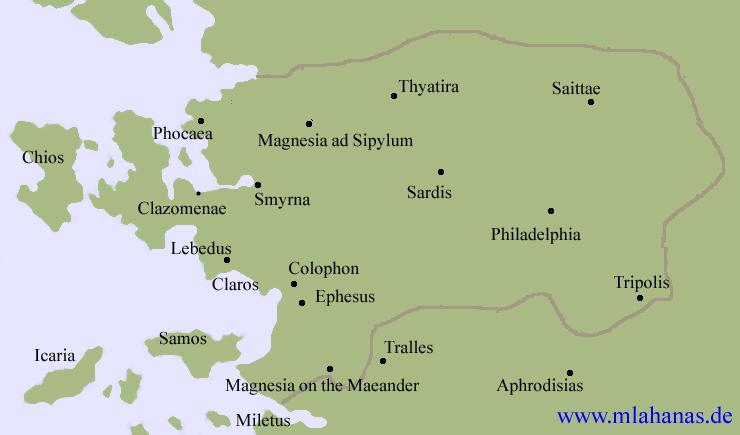.

Magnesia ad Sipylum was a city of Lydia, situated about 65 km northeast of Smyrna on the river Hermus at the foot of Mount Sipylus. Nowadays this is the location of Manisa in Turkey.
No mention of the town is found till 190 BC, when Antiochus the Great was defeated in the battle of Magnesia by the Roman consul Lucius Scipio Asiaticus. It became a city of importance under the Roman dominion and, though nearly destroyed by an earthquake in the reign of Tiberius, was restored by that emperor and flourished through the Roman empire. It was one of the few towns in this part of Asia Minor which remained prosperous under the Turkish rule. The most famous relic of antiquity is the Niobe of Sipylus (Suratlu Tash) on the lowest slopes of the mountain about 6 km east of the town. This is a colossal seated image cut in a niche of the rock, of Hittite origin, and perhaps that called by Pausanias the very ancient statue of the Mother of the Gods, carved by Broteas, son of Tantalus, and sung by Homer. Near it lie many remains of a primitive city, and about a kilometer east is the rock-seat conjecturally identified with Pausanias' Throne of Pelops. There are also hot springs and a sacred grotto of Apollo. The whole site seems to be that of the early Tantalus city.
References
168. Manisa / Magnesia on Sipylus. Archaeological Atlas of the Aegean, map 168. Retrieved March 10, 2006.
This article incorporates text from the 1911 Encyclopædia Britannica, a publication in the public domain.
| Ancient Greece
Science, Technology , Medicine , Warfare, , Biographies , Life , Cities/Places/Maps , Arts , Literature , Philosophy ,Olympics, Mythology , History , Images Medieval Greece / Byzantine Empire Science, Technology, Arts, , Warfare , Literature, Biographies, Icons, History Modern Greece Cities, Islands, Regions, Fauna/Flora ,Biographies , History , Warfare, Science/Technology, Literature, Music , Arts , Film/Actors , Sport , Fashion --- |
Retrieved from "http://en.wikipedia.org/"
All text is available under the terms of the GNU Free Documentation License


